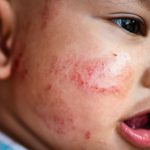Resolving Atopic Eczema
Stopping The Straw That Broke the Camel’s Back
Chris D. Meletis, ND
We have always been told not to judge a book by its cover, yet an adult’s life journey is all too often written over his or her 21 square feet of skin. Healthcare providers and even the lay public can gauge the wellness of a friend or family member they have not seen for awhile, simply by looking at the friend or family member’s skin – although this is something most often noticed subconsciously.
As the largest detoxification organ, the skin demands adequate nourishment and care to perform properly. Our skin is a reflection of our inner health, including but not limited to toxin burden, immune dysfunction, infection, gastrointestinal health, and several nutrient insufficiencies. When a patient develops a skin disease such as eczema, it most often reflects an imbalance of 1 or more of these factors. Let’s explore what our patient’s body is trying to communicate about pathophysiological and nutrient imbalance as it pertains to eczema. In this article I will provide you with clinical insights from my own practice with regard to the best approaches to help our patients. For the purposes of the article, I will use the words eczema and atopic dermatitis interchangeably.
Eczema and the Atopic Triad
Eczema, often known as atopic dermatitis, is a chronic inflammatory skin disorder that results in lesions, dryness, and severe itching. It affects 15% to 30% of children and 2% to 10% of adults.1 Most children develop eczema before they reach the age of 5, with 60% of children developing the condition during the first year of life.2 Despite the higher prevalence of eczema in children, this condition continues to plague many adults as well, as evidenced by the fact that only 60% of kids who have eczema experience a resolution of the disease by adulthood.3
Eczema is part of what’s known as the Atopic March. This refers to the progression from atopic dermatitis in infancy to the development of allergic rhinitis and asthma later in childhood.3 Approximately 1 in 3 young children with eczema will develop asthma later in childhood.4 According to 1 study, the odds of developing asthma and rhinitis are 3-fold higher in children with eczema compared to children without eczema.5 The greater the severity and the earlier the onset of eczema in a child, the higher the risk of developing asthma and rhinitis.5
Conventional therapy for eczema treats the specific symptoms and does not take into account the total body burden that may be contributing to its development, nor does it investigate the cause of the eczema in individual patients. A common strategy employed by conventional practitioners is topical corticosteroids, the use of which can cause a rebound reaction, whereby the eczema can become more severe following withdrawal of the steroids than it was prior to treatment.6 Sometimes, this rebound reaction is mild.6 However, more severe rebound reactions can result in papules, pustules, or erosions, which sometimes occur together with a high fever.6 In rare cases, the rebound reaction can also result in sepsis.6
Clinically, I have noticed this rebound reaction presents even more dramatically in the patient who initially was suffering from adrenal insufficiency prior to treatment with topical steroids. The adrenal cortex, as a healthy baseline, produces 20 mg of hydrocortisone per day; in a “healthy” individual, that will surge acutely by 5 to 20 mg during trauma, infection, and fever. However, if a patient was underproducing cortisol prior to the onset of the rash and exogenous use of corticosteroids, this rebound can be even more dramatic.
Understanding the Mechanisms of Atopic Dermatitis
Before I discuss my standard protocol for eczema, it’s important to understand why this atopic disease develops. Understanding the mechanisms involved will also help improve nutraceutical selection when developing an appropriate regimen for patients.
The skin serves as the protector from the outside world and is the body’s first line of physical defense. Patients who suffer from eczema have poor skin integrity. From a genetic perspective, individuals who have eczema are more likely to have genetic impairments in a protein known as filaggrin, which is involved in the strengthening of the skin barrier.7 Filaggrin produces breakdown products that help form natural moisturizing factors. The absence of these breakdown products results in excessive epidermal permeability, water loss, and enhanced ability of allergens to penetrate the skin.8 This increased skin permeability combined with the immune impairment that occurs in atopic dermatitis may open the door for increased skin colonization of bacteria such as Staphylococcus species, which exacerbate the disease.7-9
T-cells also play a prominent role in development of allergic diseases. In a healthy individual, regulatory T-cells (Treg) are involved in reducing sensitization to allergens.10,11 The antigen-specific Treg release anti-inflammatory cytokines such as interleukin (IL)-10 and/or transforming growth factor (TGF)-β, and have the potential to inhibit IgE production and Th1/Th2 proliferation.11 Evidence has emerged that allergen-specific Treg responses are potentially impaired in allergic diseases that feature imbalances between allergen-specific Treg and Th1/Th2 cells.12,13
Cytokines in the upper layer of the epidermis also play a role in atopic dermatitis. They are involved in symptom manifestation, particularly the severe itching that accompanies eczema.8 Cytokines are known to impair the expression, production, and function of filaggrin, consequently weakening the skin barrier.8
Treating Total Body Burden
Eczema presents most commonly after either a specific exposure or a total burden to the body, triggering the pathophysiological presentation. This differs greatly from other skin conditions, for example dermatitis herpetiformis, where gluten is the generally accepted culprit; this makes clinical management relatively easy, since gluten avoidance routinely removes the trigger. Conversely, eczema can provide some of our more challenging clinical cases because it often presents with a “total burden”-triggered rash, where contributors frequently include food and environmental allergic triggers and/or an underlying gastrointestinal (GI) dysbiosis or overt disease such as inflammatory bowel.
Consequently, with eczema, my goal is to address any factor contributing to the total body burden while at the same time relieving any discomfort. This approach includes 1) identifying dietary and environmental allergic triggers; 2) addressing any gut involvement; 3) oral supplementation with targeted nutrients; and 4) topical approaches.
Identifying Dietary and Environmental Allergic Triggers
In patients with eczema, total body burden essentially serves as the straw that broke the camel’s back. Therefore, it is critical that we investigate dietary and environmental allergic triggers.
Patients and functional medicine practitioners appreciate the concept of “food as medicine” because the right food for a given patient demonstrates amazing nourishment and quality-of-life improvements. However, with regard to food, a concept that is harder for patients to grasp is that “one shoe does not fit all” concept – what I term the Cinderella Phenomenon. Eating salads may be good for most patients; however, I have detected both IgE and IgG intolerances to lettuce in more than 1 patient.
Pinpointing food allergies in eczema patients is especially critical, since a strong connection exists between allergic sensitization to food and skin conditions. In the past, sensitization to food was thought to be mediated primarily through the GI tract. However, recent evidence indicates that sensitization to a food antigen can actually occur through the skin.14 Furthermore, developing eczema before the age of 1 significantly correlates with higher odds of food allergies.15 Children who have moderate or severe eczema have a much higher prevalence of food allergies compared to healthy children, with an estimated one-third of children with moderate or severe eczema also experiencing food allergies.16
There is finally a growing global awareness that food allergies have a part to play in the development of eczema.17 Studies indicate that eggs and cow’s milk trigger flare-ups of eczema, especially in infants.18 In 1 study, more than 80% of children reacted to at least 1 food allergen, and 94% experienced clinical symptoms to 1 or 2 allergens.19
While eggs and cow’s milk are common triggers for infants, inhaled allergens and pollen-related foods are more likely to cause a reaction in older children, adolescents, and adults.18 This reaction to pollen-related foods is due to a cross-reactivity between pollens and foods. In fact, there is evidence that most food allergies in adolescents and adults develop because of cross-reaction to pollen allergens.20
One example of cross-reactivity is that people who are allergic to birch pollen often also react to hazelnuts and apples.21 In fact, birch-related foods can provoke the development of eczema in children and adults.22 Grass pollen allergies also are common in eczema patients,23 and patients allergic to grass pollen also can react to peanuts, garlic, tomatoes, potatoes, green peas, watermelon, melon, apple, orange, kiwi, onion, and peach.24 This is why in clinical practice I always test eczema patients for delayed and IgE-mediated food reactivity, and then recommend that they withdraw from their diet any offending foods while minimizing cross-reacting environmental exposures, and vice versa.
Other allergic triggers for eczema include animal dander, molds, and tobacco smoke.8,25,26 Furthermore, a meta-analysis published in March 2015 suggests that exposure to traffic-related air pollution in early childhood is associated with development of eczema and hay fever later in life.27
Addressing Any Gut Involvement
Given that nearly 70% of the entire immune system is located in the gut,28 it is logical that the gut should play a role in allergy-related diseases such as eczema.29 The gut microbiota plays an important role in stimulating immune system development and maturation, including the ability to rebalance the Th1/Th2 ratio.30 Increasing evidence indicates that the gut microbiota that first takes up residence during the early postnatal period is critical for the proper development of Treg.14,31
An imbalanced gut microbiota is associated with the development of eczema. Reduced gut microbial diversity during the first month of life has been shown to correlate with the occurrence of atopic eczema at 2years of age.32 The composition of the gut microbiota also differs between infants who developed eczema by the age of 5, infants who developed eczema by age 2, and healthy controls.33
Studies have indicated that probiotics may play a role in both the inhibition and management of atopic eczema and allergic rhinitis. Probiotics have been shown to regulate microbial colonization of infants, alleviate the increased intestinal permeability often present in children with eczema and food allergies, and improve gut-specific IgA responses, which are often impaired in children with food allergies. Furthermore, probiotics can reduce allergy-triggered inflammatory responses both locally and systemically.34
Although there is some inconsistency in the literature, Lactobacillus rhamnosus GG (LGG) in several studies has been shown to have a beneficial effect in atopic dermatitis,35-37 with 1 study indicating it is more effective in IgE-sensitized infants compared to non-IgE-sensitized infants.37 Another study found that LGG ameliorated some of the immune-suppressing effects of birch pollen allergy in 19 human subjects. LGG stimulated mucosal immunity as demonstrated by increased allergen-specific IgA levels in the saliva in the subjects given LGG compared to subjects taking a placebo.38
Emphasizing the concept of treating each individual rather than utilizing a 1-size-fits-all approach, stool testing helps target probiotic strains that may be insufficient in a given patient.
Oral Supplementation with Targeted Nutrients
Another strategy I employ in resolving total body burden in eczema patients is to ensure that they are supplementing with nutrients shown to be depleted or beneficial in eczema patients. Vitamin D3 is one of these nutrients. Some, but not all studies, have indicated an association between low vitamin D levels in early life and increased risk of developing allergic diseases later in childhood.39 Emerging evidence also suggests a possible role for vitamin D in enhancing immunity at the cutaneous level and inhibiting the eczema-exacerbation effect of microorganisms such as Staphylococcus species.9
Another useful nutrient in eczema patients is zinc. Recently, one group of researchers found that hair zinc levels were significantly reduced in 58 children, aged 2 to 14, who suffered from atopic dermatitis, compared to 43 controls. The same researchers gave zinc supplements for 8 weeks to a group of children with atopic dermatitis who had low zinc hair levels. In the treated group, there was a marked increase in hair zinc levels and a greater improvement in eczema assessment severity index, transepidermal water loss, and visual analogue scales for pruritus in the zinc-supplemented children, compared to children with atopic dermatitis who did not receive zinc supplements.40
Additionally, supplementing with an evening primrose supplement high in gamma-linolenic acid (GLA), or with GLA directly, may provide beneficial effect. Some atopic dermatitis patients have a deficiency of delta-6-desaturase, the enzyme that converts linoleic acid to GLA.1 Breast milk from mothers of children who recently developed atopic dermatitis has an abnormal fatty acid profile, with increased proportions of linoleic acid and significantly decreased proportions of linoleic acid metabolites such as GLA.41 Eating GLA-containing foods or supplementing with 4-6 grams of GLA daily has improved the transepidermal water loss index42 and reduced clinical disease activity.1
I also encourage my pregnant patients to supplement with omega-3 fatty acids. This is based on studies that show supplementation with omega-3 PUFA supplements during pregnancy and breastfeeding modulates immunity in the newborn and reduces the risk of early sensitization to allergens, reduces the prevalence of children who develop food allergy postnatally, and ameliorates symptom severity in atopic dermatitis.43
Topical Approaches
One approach I always recommend to my eczema patients is to use cooled licorice tea as a spritz on the skin. This is based not only on my clinical experience but also on some reports in the medical literature that Glycyrrhiza glabra (licorice) can be helpful for atopic dermatitis.44,45
Another approach is to use colloidal oatmeal lotion. Colloidal oats have been used for centuries to soothe a variety of skin conditions, including skin rashes, erythema, burns, itch, and eczema. Colloidal oatmeal extracts have been found to reduce proinflammatory cytokines in vitro, and colloidal oat lotion used on the skin of human subjects resulted in marked improvements in dry skin, scaling, roughness, and itch intensity.46
Finally, I urge my eczema patients to spend a little time out in the sun, weather-permitting, not only to receive nourishing levels of vitamin D, but also because a small amount of sunlight exposure may be highly beneficial to many eczema patients. This needs to be done with caution, since it has been reported that some cases of eczema can be aggravated by sunlight exposure.47 However, one study showed that 74.4% of patients affected by mild-moderate atopic dermatitis had complete resolution during summer vacation where they were exposed to sunlight. Another 16.3% of the eczema patients improved after sunlight exposure, whereas only 9.3% saw no improvement.48
A Comprehensive Strategy
I often share with a patient the following question as a philosophical consideration: If a person’s finger hurts, he or she might receive advice from friends and healthcare providers to take an NSAID or acetaminophen, increase anti-inflammatory botanicals or fish oil, or apply ice, all of which may ameliorate the immediate discomfort; however, I ask them, would it not be best to eliminate the cause of the pain to begin with by removing the splinter in the finger? A total body burden approach to treating eczema strives to eliminate the root cause, allowing us to simultaneously address the underlying cause(s) that have triggered the body to communicate its disharmonious state, while at the same time considering patient comfort.
 Chris D. Meletis, ND, is an educator, international author, and lecturer. He serves as the executive director for The Institute for Healthy Aging. His personal mission is “Changing the World’s Health One Person at a Time.” He believes that when people become educated about their body, that is the moment when true change and wellness begins. Dr Meletis has authored/co-authored 12 books; he has also authored over 250 national scientific articles in journals and magazines. Dr Meletis served as Dean of Naturopathic Medicine and Chief Medical Officer at NCNM for 7 years, and was awarded the 2003 Physician of the Year by the American Association of Naturopathic Physicians. Website: www.DrMeletis.com
Chris D. Meletis, ND, is an educator, international author, and lecturer. He serves as the executive director for The Institute for Healthy Aging. His personal mission is “Changing the World’s Health One Person at a Time.” He believes that when people become educated about their body, that is the moment when true change and wellness begins. Dr Meletis has authored/co-authored 12 books; he has also authored over 250 national scientific articles in journals and magazines. Dr Meletis served as Dean of Naturopathic Medicine and Chief Medical Officer at NCNM for 7 years, and was awarded the 2003 Physician of the Year by the American Association of Naturopathic Physicians. Website: www.DrMeletis.com
References:
- Simon D, Eng PA, Borelli S, et al. Gamma-linolenic acid levels correlate with clinical efficacy of evening primrose oil in patients with atopic dermatitis. Adv Ther. 2014;31(2):180-188.
- Kay J, Gawkrodger DJ, Mortimer MJ, Jaron AG. The prevalence of childhood atopic eczema in a general population. J Am Acad Dermatol. 1994;30(1):35-39.
- Bantz SK, Zhu Z, Zheng T. The Atopic March: Progression from Atopic Dermatitis to Allergic Rhinitis and Asthma. J Clin Cell Immunol. 2014;5(2):pii:202.
- van der Hulst AE, Klip H, Brand PL. Risk of developing asthma in young children with atopic eczema: a systematic review. J Allergy Clin Immunol. 2007;120(3):565-569.
- von Kobyletzki LB, Bornehag CG, Hasselgren M. Eczema in early childhood is strongly associated with the development of asthma and rhinitis in a prospective cohort. BMC Dermatol. 2012;12:11.
- Fukaya M, Sato K, Sato M. Topical steroid addiction in atopic dermatitis. Drug Healthc Patient Saf. 2014;6:131-138.
- Robert GP Forsey. Prevalence of childhood eczema and food sensitization in the First Nations reserve of Natuashish, Labrador, Canada. BMC Pediatr. 2014;14:76.
- Wittmann M, McGonagle D, Werfel T. Cytokines as therapeutic targets in skin inflammation. Cytokine Growth Factor Rev. 2014;25(4):443-451.
- Benetti C, Piacentini GL, Capristo C. Microorganism-induced exacerbations in atopic dermatitis: A possible preventive role for vitamin D? Allergy Asthma Proc. 2015;36(1):19-25.
- Prioult G, Nagler-Anderson C. Mucosal immunity and allergic responses: lack of regulation and/or lack of microbial stimulation? Immunol Rev. 2005;206:204-218.
- Akdis M, Blaser K, Akdis CA. T regulatory cells in allergy: novel concepts in the pathogenesis, prevention, and treatment of allergic diseases. J Allergy Clin Immunol. 2005;116(5):961-968.
- AKdis M, Verhagen J, Taylor A, et al. Immune responses in healthy and allergic individuals are characterized by a fine balance between allergen-specific T regulatory 1 and T helper 2 cells. J Exp Med. 2004;199:1567-1575.
- Kalliomäki M, Antoine JM, Herz U, et al. Guidance for substantiating the evidence for beneficial effects of probiotics: prevention and management of allergic diseases by probiotics. J Nutr. 2010;140(3):713S-21S.
- Inomata N, Nagashima M, Hakuta A, Aihara M. Food allergy preceded by contact urticaria due to the same food: Involvement of epicutaneous sensitization in food allergy. Allergol Int. 2015;64(1):73-78.
- Luccioli S, Zhang Y, Verrill L, et al. Infant feeding practices and reported food allergies at 6 years of age. 2014;134 Suppl 1:S21-28.
- Eigenmann PA, Sicherer SH, Borkowski TA, et al. Prevalence of IgE-mediated food allergy among children with atopic dermatitis. Pediatrics. 1998;101(3):E8.
- Forsey RG. Prevalence of childhood eczema and food sensitization in the First Nations reserve of Natuashish, Labrador, Canada. BMC Pediatr. 2014;14:76.
- Werfel T, Ballmer-Weber B, Eigenmann PA. Eczematous reactions to food in atopic eczema: position paper of the EAACI and GA2LEN. Allergy. 2007;62(7):723-728.
- Niggemann B, Sielaff B, Beyer K. Outcome of double-blind, placebo-controlled food challenge tests in 107 children with atopic dermatitis. Clin Exp Allergy.1999;29(1):91-96.
- Ballmer-Weber BK. Allergic reactions to food proteins. Int J Vitam Nutr Res. 2011;81(2-3):173-180.
- Ballmer-Weber B. [Food allergy from school age to adulthood]. [Article in German] Ther Umsch. 2012;69(4):225-229.
- Bergmann MM, Caubet JC, Boguniewicz M, Eigenmann PA. Evaluation of food allergy in patients with atopic dermatitis. J Allergy Clin Immunol Pract. 2013;1(1):22-28.
- Govaere E, Van Gysel D, Verhamme KM, et al. The prevalence, characteristics of and risk factors for eczema in Belgian schoolchildren. Pediatr Dermatol. 2009;26(2):129-138.
- Boccafogli A, Vicentini L, Camerani A, et al. Adverse food reactions in patients with grass pollen allergic respiratory disease. Ann Allergy. 1994;73(4):301-308.
- Wichmann J, Wolvaardt JE, Maritz C, Voyi KV. Association between children’s household living conditions and eczema in the Polokwane area, South Africa. Health Place. 2008;14(2):323-335.
- Morales Suárez-Varela M, García-Marcos L, Kogan MD, et al. Parents’ smoking habit and prevalence of atopic eczema in 6-7 and 13-14 year-old schoolchildren in Spain. ISAAC phase III. Allergol Immunopathol (Madr). 2008;36(6):336-342.
- Bowatte G, Lodge C, Lowe AJ, et al. The influence of childhood traffic-related air pollution exposure on asthma, allergy and sensitization: a systematic review and a meta-analysis of birth cohort studies. Allergy. 2015;70(3):245-256.
- Vighi G, Marcucci F, Sensi L, et al. Allergy and the gastrointestinal system. Clin Exp Immunol. 2008;153 Suppl 1:3-6.
- Munyaka PM, Khafipour E, Ghia JE. External influence of early childhood establishment of gut microbiota and subsequent health Front Pediatr. 2014;2:109.
- Madonini ER. Probiotics and allergies: myth or reality? Eur Ann Allergy Clin Immunol. 2014;46(6):196-200.
- Ostman S, Rask C, Wold AE, et al. Impaired regulatory T cell function in germ-free mice. Eur J Immunol. 2006;36:2336-346.
- Abrahamsson TR, Jakobsson HE, Andersson AF, et al. Low diversity of the gut microbiota in infants with atopic eczema. J Allergy Clin Immunol. 2012;129(2):434-440.
- Yap GC, Ling EX, Marion L, et al. Molecular analysis of infant fecal microbiota in an Asian at-risk cohort–correlates with infant and childhood eczema. BMC Res Notes. 2014;7:166.
- Isolauri E, Rautava S, Salminen S. Probiotics in the development and treatment of allergic disease. Gastroenterol Clin North Am. 2012;41(4):747-762.
- Majamaa H, Isolauri E. Probiotics: a novel approach in the management of food allergy. J Allergy Clin Immunol. 1997;99(2):179-185.
- Isolauri E, Arvola T, Sütas Y, et al. Probiotics in the management of atopic eczema. Clin Exp Allergy. 2000;30(11):1604-1610.
- Viljanen M, Savilahti E, Haahtela T, et al. Probiotics in the treatment of atopic eczema/dermatitis syndrome in infants: a double-blind placebo-controlled trial. 2005;60(4):494-500.
- Piirainen L, Haahtela S, Helin T, et al. Effect of Lactobacillus rhamnosus GG on rBet v1 and rMal d1 specific IgA in the saliva of patients with birch pollen allergy. Ann Allergy Asthma Immunol. 2008;100(4):338-342.
- Jones AP, D’Vaz N, Meldrum S, et al. 25-hydroxyvitamin D3 status is associated with developing adaptive and innate immune responses in the first 6 months of life. Clin Exp Allergy. 2015;45(1):220-231.
- Kim JE, Yoo SR, Jeong MG, et al. Hair zinc levels and the efficacy of oral zinc supplementation in patients with atopic dermatitis. Acta Derm Venereol. 2014;94(5):558-562.
- Businco L, Ioppi M, Morse NL, et al. Breast milk from mothers of children with newly developed atopic eczema has low levels of long chain polyunsaturated fatty acids. J Allergy Clin Immunol. 1993;91(6):1134-1139.
- Kawamura A, Ooyama K, Kojima K, et al. Dietary supplementation of gamma-linolenic acid improves skin parameters in subjects with dry skin and mild atopic dermatitis. J Oleo Sci. 2011;60(12):597-607.
- Miles EA, Calder PC. Maternal diet and its influence on the development of allergic disease. Clin Exp Allergy. 2015;45(1):63-74.
- Reuter J, Wölfle U, Weckesser S, Schempp C. Which plant for which skin disease? Part 1: Atopic dermatitis, psoriasis, acne, condyloma and herpes simplex. J Dtsch Dermatol Ges. 2010;8(10):788-796.
- Reuter J, Merfort I, Schempp CM. Botanicals in dermatology: an evidence-based review. Am J Clin Dermatol. 2010;11(4):247-267.
- Reynertson KA, Garay M, Nebus J, et al. Anti-Inflammatory Activities of Colloidal Oatmeal (Avena sativa) Contribute to the Effectiveness of Oats in Treatment of Itch Associated With Dry, Irritated Skin. J Drugs Dermatol. 2015;14(1):43-48.
- O’Gorman SM, Murphy GM. Photoaggravated disorders. Dermatol Clin. 2014;32(3):385-398.
- Patrizi A, Savoia F, Giacomini F, et al. The effect of summer holidays and sun exposure on atopic dermatitis. G Ital Dermatol Venereol. 2009;144(4):463-466.










